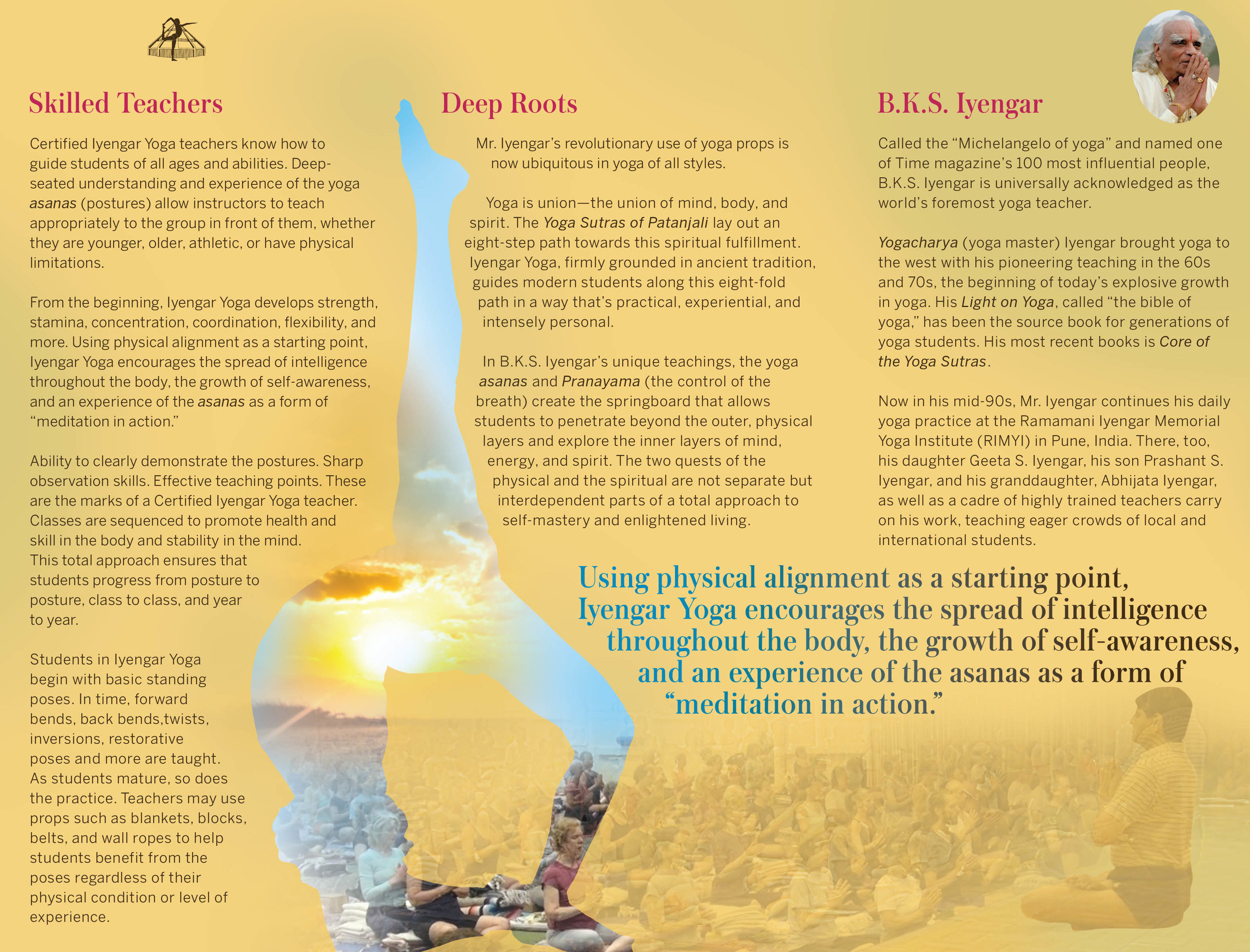Iyengar Yoga
An innovative and inspired practice of yoga, the Iyengar method was developed by yoga master B.K.S. Iyengar throughout a long career. Firmly based in the ancient Indian tradition of classical Ashtanga yoga as defined in Patanjali’s Yoga Sutras, Iyengar Yoga teaches strength and stamina, flexibility and balance, concentration and meditation. In Iyengar Yoga, the search for a developed consciousness begins with physical awareness. In each posture, every part of the body is acted upon with intent and precision.
Yet Iyengar Yoga goes beyond the physical being to embrace emotional and spiritual growth. As students learn to extend awareness to each part of their body, they begin to explore the limitless potential of the mind and the soul. The two quests of the physical and the spiritual are not separate but parts of a complementary approach to self-realization and enlightenment.
Iyengar yoga is based on the teachings of the yoga master B.K.S. Iyengar, author of many books including the classic yoga treatise Light on Yoga. Iyengar began teaching in Pune, India, in 1936 at the age of 18. His daughter, Geeta, and his son, Prashant, and his granddaugher, Abhijata, are also accomplished teachers and authors of yoga texts.
The Iyengar family’s teachings are deeply grounded in the Yoga Sutras of Patanjali, an ancient summation of the path of yoga considered to be at least 2,500 years old. B.K.S. Iyengar's intense practice and almost seventy years of teaching have produced significant innovations in the teaching of the art and science of yoga. Achieving meditation in action, students learn to exist fully and vibrantly in the present moment.
The Iyengar Yoga Experience
From the Iyengar Yoga National Association of the United States (IYNAUS):
“Yoga is for everyone. No one is too old or too stiff, too fat or thin or tired. A Certified Iyengar Yoga teacher can guide students of all ages and physical conditions to an experience of yoga, which is safe, accessible and rewarding.
Certified Iyengar Yoga instructors are held to an unusually rigorous standard. Only after years of training and evaluation do they become certified. Iyengar Yoga teachers modify the classic asanas (yoga postures) for individual students with the use of props — such as blocks, blankets and belts. Props allow for a deeper penetration into the posture, as well as a longer stay.
Iyengar Yoga teachers use their deep-seated knowledge of the asanas to individualize corrections for each student. Students know they are observed and, if necessary, adjusted. Clear demonstrations of the posture. A well-developed eye. Specific teaching points which awaken the body’s intelligence - these are the marks of an Iyengar Yoga teacher.
Students of Iyengar Yoga begin with elementary postures, with an emphasis on the standing asanas (postures). In time, other postures are added, including forward bends and back bends, twists, inversions and restorative poses. Salamba Sarvangasana (Shoulder Balance) is introduced as soon as students are ready because of its many therapeutic benefits. Each class ends with Savasana, corpse pose or deep relaxation. Students learn to rest in a profound way, completely releasing the body while drawing the mind towards the peace within.
As the student progresses, Pranayama (the control of the breath) is introduced.
Teachers devise sequences of poses, which build skill and understanding, from posture to posture, and from class to class. Students are encouraged to develop their own home practice; without one, the study of yoga is incomplete.”
What to Expect from this Method of Yoga
- Qualified and rigorously trained instructors committed to excellence in teaching
- A safe and systematic progression of yoga postures to develop each student's ability and skill, both within each class and from class to class
- Sequencing that develops strength, flexibility, stamina, concentration, and body alignment
- Individual correction and knowledge of how to adjust postures for common physical problems
- Precise use of language
- Demonstration and teaching of specific points to develop understanding and intelligent action
- Individual correction and adjustment of students, when necessary
- Integration of the yoga philosophy with the practice of asana
- Progressive and systematic approach that builds from the foundation learned in beginning classes to advanced classes.
- Incorporation and relevance of practice into daily life
- Ways to use yoga to ease various ailments and stress
- Use of props, such as blankets, blocks, and straps, to facilitate learning and adjust yoga postures to suit individual needs
How Does Iyengar Yoga differ from other systems of yoga?
The Iyengar method develops strength, endurance, and optimal body alignment, in addition to flexibility and relaxation. The Iyengar method develops self-awareness, intelligent evaluation, and profound inward reflection. The attention to detail and cultivation of awareness is meant to not only maintain physical safety in the practice, but to develop the mental benefits of a complete meditation in action.
No two classes are ever exactly the same. The variation in sequencing of Iyengar classes is influenced by the level and condition of the student, time of day, time of year, and many other factors. In Iyengar yoga classes, the emphasis is on learning, not just doing, so the teacher will usually teach through instruction, demonstration or adjustment so that the student can fully absorb the process and gain a more in-depth understanding of themselves.
Standing poses are emphasized at the beginning to build strength and ease of movement, increase general vitality, and improve circulation, coordination, and balance, ensuring a strong foundation for the study of the other categories of and more advanced poses.
Postures for deep relaxation are introduced from the beginning. Gradually, sitting and reclining postures, forward bends, inversions, backbends, twists, arm balances, and flowing sequences are introduced.


